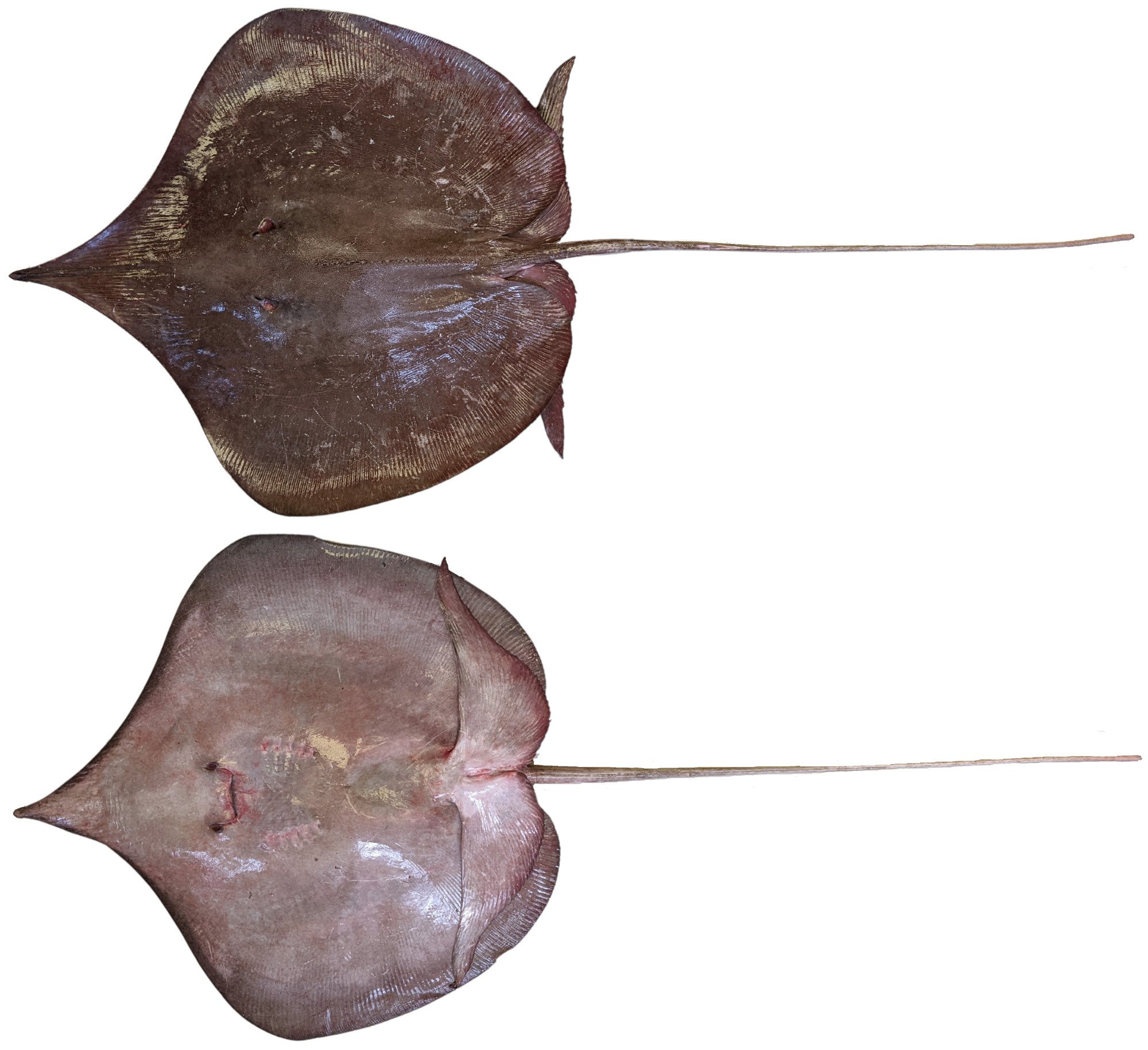Hypanus geijskesi
(Boeseman, 1948)
Sharpsnout stingray
Classification: Elasmobranchii Myliobatiformes Dasyatidae
Reference of the original description
Some preliminary notes on Surinam sting rays, including the description of a new species. Zoologische Mededelingen, 30(2), 31–47
Some preliminary notes on Surinam sting rays, including the description of a new species. Zoologische Mededelingen, 30(2), 31–47
Image of the original description

Hypanus geijskesi, holotype, from Coppenam Point, Surinam, coll. Dr. D. C Geijskes, July 1944,measuring 1060 mm (disc 360 mm), tail mutilated

Hypanus geijskesi, holotype, from Coppenam Point, Surinam, coll. Dr. D. C Geijskes, July 1944,measuring 1060 mm (disc 360 mm), tail mutilated
Synonyms / new combinations and misspellings
Amphotistius geijskesi, Dasyatis geijskesi, Fontitrygon geijskesi
Amphotistius geijskesi, Dasyatis geijskesi, Fontitrygon geijskesi
Description :
Citation: Hypanus geijskesi (Boeseman, 1948): In: Database of modern sharks, rays and chimaeras, www.shark-references.com, World Wide Web electronic publication, Version 12/2025
Please send your images of "Hypanus geijskesi" to info@shark-references.com

Hypanus geijskesi (Boeseman, 1948), female, 170 cm TL, 86 cm DL, 81.5 cm DW, Gulf of Paria, Trinidad, 8th August 2022, by trawling (Type IV Trawler) © Dr. Farahnaz N. Solomon

Hypanus geijskesi (Boeseman, 1948), female, 170 cm TL, 86 cm DL, 81.5 cm DW, Gulf of Paria, Trinidad, 8th August 2022, by trawling (Type IV Trawler) © Dr. Farahnaz N. Solomon
Common names
 Raja-látigo picúa,
Raja-látigo picúa,  Pastenague bécune,
Pastenague bécune,  Sharpsnout stingray,
Sharpsnout stingray,  Stingray,
Stingray,  Wingfin stingray,
Wingfin stingray,  Arraia,
Arraia,  Arraia-morcego,
Arraia-morcego,  Raia,
Raia,  Raia-bicuda
Raia-bicuda
 Raja-látigo picúa,
Raja-látigo picúa,  Pastenague bécune,
Pastenague bécune,  Sharpsnout stingray,
Sharpsnout stingray,  Stingray,
Stingray,  Wingfin stingray,
Wingfin stingray,  Arraia,
Arraia,  Arraia-morcego,
Arraia-morcego,  Raia,
Raia,  Raia-bicuda
Raia-bicuda
Short Description
Disc is narrowly projecting to snout, pelvic fins with long anterior margins. Narrowly pointed falcate outer corners. Upper surface dark brown, lower surface pale with darker margins and teeth as yellowish white [199].
Disc is narrowly projecting to snout, pelvic fins with long anterior margins. Narrowly pointed falcate outer corners. Upper surface dark brown, lower surface pale with darker margins and teeth as yellowish white [199].
Distribution
Western Atlantic: northern coast of Venezuela extending southward to Brazil.
Western Atlantic: northern coast of Venezuela extending southward to Brazil.
Human uses
fisheries: minor commercial; price category: low; price reliability: very questionable: based on ex-vessel price for species in this family
fisheries: minor commercial; price category: low; price reliability: very questionable: based on ex-vessel price for species in this family
Biology
Exhibit ovoviparity (aplacental viviparity), with embryos feeding initially on yolk, then receiving additional nourishment from the mother by indirect absorption of uterine fluid enriched with mucus, fat or protein through specialised structures [733]. Distinct pairing with embrace [17086].
Exhibit ovoviparity (aplacental viviparity), with embryos feeding initially on yolk, then receiving additional nourishment from the mother by indirect absorption of uterine fluid enriched with mucus, fat or protein through specialised structures [733]. Distinct pairing with embrace [17086].
Remarks
shark-references Species-ID=17403;
reclassified as Hypanus geijskesi by Petean et al. (2024) [32957]
shark-references Species-ID=17403;
reclassified as Hypanus geijskesi by Petean et al. (2024) [32957]

















